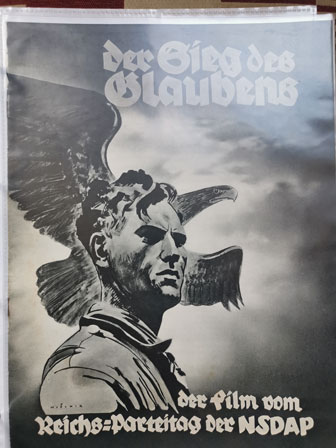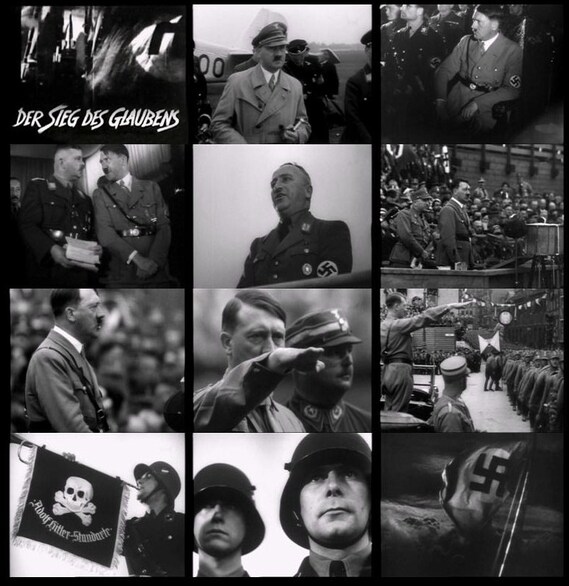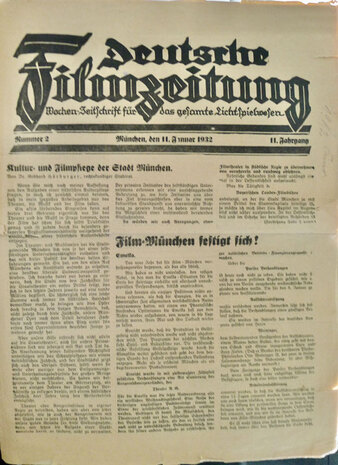- Home
- POSTER GALLERY
- ❗️BOOK & POSTER STORE❗️
- PURCHASE "HJ Quex" film ephemera HQ
- About the Posters
- The William Gillespie Collection
- Our Publishing House
- ❗️GFDN interviews author and collector William Gillespie ❗️
- Our most expensive & inexpensive finds!
- ❗️***NEW!**❗️POSTER OF THE MONTH - Blutzeugen / Raza
- ❗️NEW ❗️Film Posters – Demands on an important means of film advertising. ❗️
- In our Book + Zeitschrift Library
- ❗️ ***NEW!*** Hitler Youth Quex – A Guide for the English–speaking Reader ***NEW!*** ❗️
- ❗️***NEW!*** Table of Contents of our new HJ QUEX book❗️
- ❗️Hitler Youth Quex Guide - early praise! ❗️
- Recent loans from the Collection
- Farewell Horst Claus. (1940–2024 †)
- "Der Deutsche Film" Zeitschrift
- ❗️ ***NEW!***Reichsfilmkammer collection ❗️
- German "Tendency" Films (Tendenzfilme) in the Third Reich
- KARL RITTER
- Karl Ritter original film posers in this Collection
- "Besatzung Dora" ( † 1943)
- "The Making of The Crew of the Dora"
- Karl Ritter at the 1938 Reichsfilmkammer Congress
- INDEX -"Karl Ritter" book, 2nd edition
- Karl Ritter's Legion Condor (1939, unfinished)
- Excerpt from our "Dora" book
- ∆∆∆∆∆ High praise for our DORA book! ∆∆∆∆∆
- TABLE OF CONTENTS – "Legion Condor"
- § § § § § Early Praise for our LEGION CONDOR book! § § § § §
- ❗️"Das Leben geht weiter" and Karl Ritter ❗️
- Dateline: Ufa - April 11, 1945
- Zarah Leander Europe–wide !
- Japan Military Film and Karl Ritter
- Karl Ritter after 1945
- 1935 Film Congress
- Poster Exhibition in Berlin, March 1939
- Potsdam poster exhibition 12 April–25 August 2019
- Leni Riefenstahl's two "Olympia" Films (1938)
- "Ohm Krüger" (1941)
- Emil Jannings
- "Blutendes Deutschland" (1933)
- Hannes Stelzer ( † 1944)
- Klaus Detlef Sierck ( † 1944)
- Film stills
- Reich Film Censorship Offices
- ❗️***NEW!***The Fate of the German Film Industry in May 1945 ❗️
- Film censorship cards
- Film Archives
- Cinema advertising
- School filmstrips
- ❗️UPDATED❗️ Z F O / Ostland Film G-m-b-H
- Z F O / Herbert Jacobi estate
- ZFO / Ostland Film newspaper articles
- ❗️***NEW!*** Roter Nebel / Red Fog / Red Mist (1942/1943, ZFO) ❗️
- ZFO - Der Rückkehrer - The Returnee (1943/1944)
- The D F G production company
- D I F U
- ❗️ ***NEW!*** "Carl Peters" – Special Collection. ❗️
- "Alcazar" (1940, Genina)
- "Der 5. Juni" (1943, banned)
- Herbert Selpin and his "Titanic" (1943)
- Ein Robinson (1940, Fanck)
- "Fronttheater" (1942)
- Veit Harlan's Jud Süß and Fritz Hippler's Der Ewige Jude
- Harlan "Jud Süß" trial 1949
- Werner Krauss & JUD SÜß
- Anti-Semitic Film Posters in the Collection
- "Heimkehr" (1941)
- "Hitlerjunge Quex" (1933)
- ❗️***NEW!*** Hitlerjunge Quex in 111 Greater Berlin Cinemas ❗️
- Jürgen Ohlsen
- "S.A.Mann Brand" (1933)
- "In der roten Hölle" (Edgar Neville, 1939)
- "Helden in Spanien" (1938)
- The Spanish Civil War in Film
- Andrews Engelmann (1901 – 1992)
- Deutsche Wochenschau
- Uƒa Feldpost
- Uƒa Kulturfilm – Informationen
- " Die Tochter des Samurai" (1937, Fanck)
- Ufa 25th Anniversary
- Invitations to world premieres
- ❗️***NEW!*** Continental Films, Paris 1940–1944 ❗️
- Film Censorship in Occupied Paris 1942
- "Der Sieg des Glaubens" (1933)
- Wilhelm Althaus Estate
- Weimar Germany posters
- Ufa and the Ordensburgen
- The Gaufilmstelle in our Collection
- "Zwei Welten" (1940)
- "Capriccio" (1938) –Karl Ritter film album
- Unrealised NS Propaganda Films 1934–1945
- German Film Directors accused of "war crimes"
- Australian––themed NS feature films
- "Der Störenfried" / "The Troublemaker"
- What was new in 2014?
- What was new in 2015?
- What was new in 2016?
- What was new in 2017?
- What was new in 2018?
- What was new in 2019?
- What was new in 2020?
- What was new in 2021?
- What was new in 2022?
- What was new in 2023 ?
- What's new in 2024?
- ❗️***NEW!*** Hitler assassination attempt in Karl Ritter film cut❗️
- BESATZUNG DORA private photos
- Just discovered 1942 article on BESATZUNG DORA
- The Karl Ritter Tetralogy
- Google Analytics 2023
- Our first–ever acquisition!
- ❤️"Some of our favourite things....!"❤️
- ERRATUM for our " Hitler Youth Quex Guide"
- Trending
- Vale †
- Our Wants List / 2024 / Wunschliste
- Pop Quiz
- Unsere KARL RITTER Bücher in Deutschland liefbar!
- WHERE to buy our books right now?
- ✉️Contact
 “History is not about the facts. It is about the context and who is telling the story.” —Prof. Milton Fine.
“History is not about the facts. It is about the context and who is telling the story.” —Prof. Milton Fine.
"Who controls the past controls the future: who controls the present controls the past." –– George Orwell in his novel "1984."
"Whoever doubts the exclusive guilt of Germany for the Second World War destroys the foundation of post–war politics." –– Prof. Theodor Eschenberg, Rector, the University of Tübingen.
"If we have our own why in life, we shall get along with almost any how." – Friedrich Nietzsche
POSTER GALLERY --view
over 500 German film
original posters between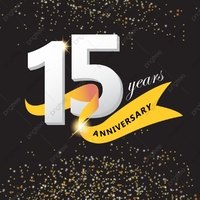
1927–1954 from
Germany and from
many Axis and Neutral countries
across Europe!
Note! Posters in the Poster Gallery are PERMANENT
acquisitions which are NOT FOR SALE!! ONLY the
posters listed in our POSTER STORE are for sale.
(They have a price and order button to use.)
The very rare 'Das Programm von Heute' for
Leni Riefenstahl's Der Sieg des Glaubens (1933)
This re-discovered film in the early 1990's allowed film students and film historians to see this first Riefenstahl Party Day Congress documentary. There is not much documentation on the film -- the sparse amount of original material is cited in the handful of Riefenstahl biographies and filmographies published after the film re–surfaced. Earlier books just ignored the film because so little documentation was found, and these books focused on Riefenstahl's Triumph des Willens. In fact some of these books never mentioned Der Sieg des Glaubens at all, so an uninformed reader could think that Triumph des Willens was her only Party Day film.
We have in our film book library over twenty post–1945 books and monographs on Riefenstahl and not a single one of them ever cites this "Das Programm von Heute" for Der Sieg des Glaubens. About 80% of all citations are from contemporary 1933/1934 German newspaper clippings. The remaining citations are a round-robin of authors citing other authors' post–war film histories, articles and books on Riefenstahl. Not much else was, or has been, available even to scholars.
For example, below is the list of sources on the film compiled by the Potsdam Film Museum for their major Riefenstahl exhibition held in 1998 is the most comprehensive bibliography we have seen. Our "Das Programm von Heute" is not amongst its many newspaper articles and other sources.
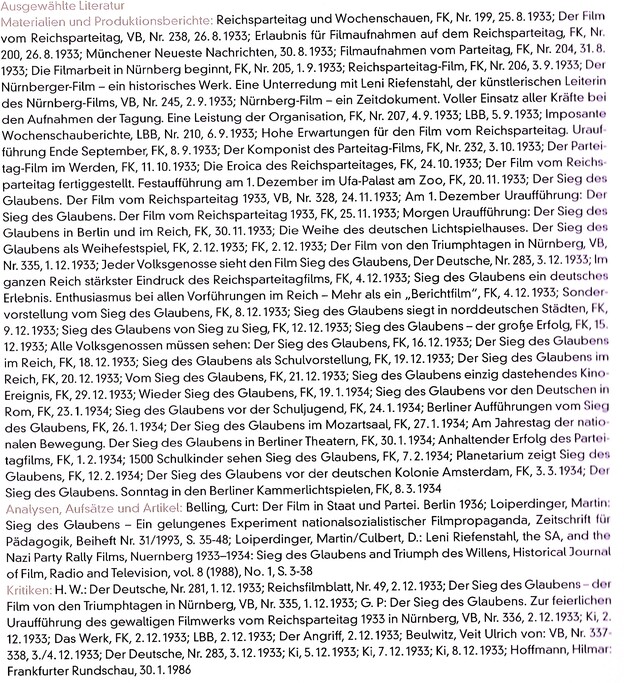
When the film was shown at the subsequent Nürnberg Party Rally it was seen by at least 100,000 people there, according to Gerhard Stahr's 2001 book Volksgmeinschaft vor der Leinwand? (S.107).
This "Das Programm von Heute" 4-page A4 sized film program for cinema–goers was published to promote the film at the time of it's premiere seasons. Copies of this brochure were included in issues of the Deutsche Filmzeitung newspaper, as well. A film expert and a very knowledgeable collector of these film programs have both indicated that the Deutsche Filmzeitung was a Munich-based paper and was not widely distributed outside of Bavaria, and that 'Das Programm von Heute' did not normally have its cinema programs enclosed with that paper. This effort for Der Sieg des Glaubens in their opinion must have been a special one.
This Der Sieg des Glaubens program sold for 10 Pfenning, or about US 5¢. We have the only known original of this program, and it still has the artist postcard intact -- in this case being a Heinrich Hoffmann postcard of Hitler. Later the "Das Programm von Heute" film publishing company printed its own postcards of film stars to attach to such cinema programs. We have some of them in our Collection. (If other originals of this 'Das Programm von Heute" exist, we would be pleased to hear from other archives.)
The front cover with die cut-out to allow the artist postcard mounted inside to be seen:
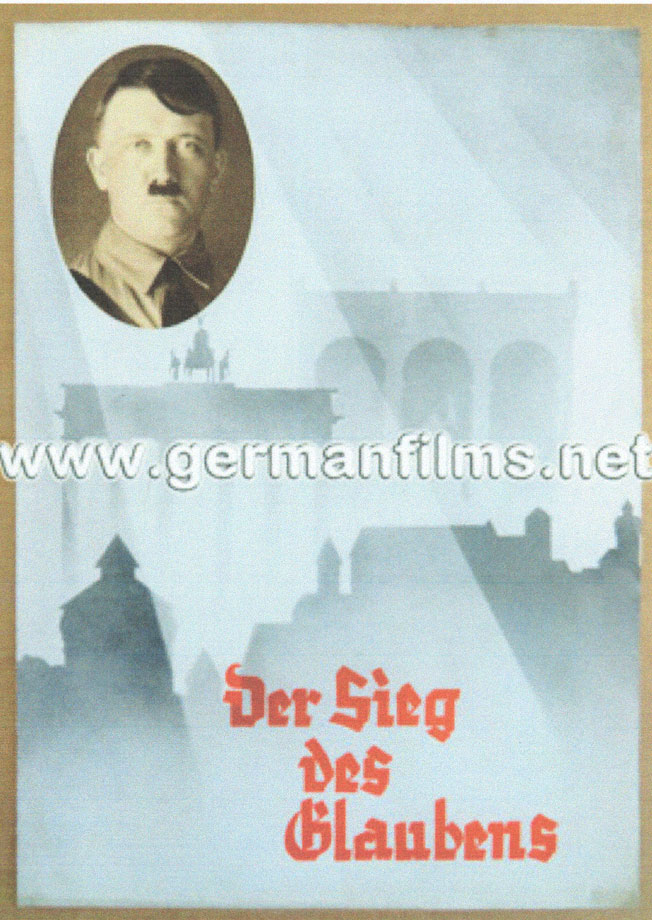
We provide here, for the first time, a translation into English of pages two and three of the brochure, as seen in the double–spread layout in the second JPEG below.
Leni Riefenstahl's enthusiasm for the commission to film the 1933 Reich Party Day Rally is unequivocally described in the second paragraph of the interview with her on page two of this Program. It is further remarked about in the second-to-last paragraph on that page. This is in strong contrast to her distancing herself from the the film in post–war memoirs and interviews. What is however also clear from this Program is that she and her camera crew and production team only arrived in Nürnberg three days prior to the first day of the Rally. This fact has often been sneered at by hostile post–war biographers who suggested that she had plenty of time to work on preparations and nonetheless tried to deny it later.
Page 2 text:
Victory of Faith
How the Reich Party Day Film originated
A discussion with Leni Riefenstahl
On Bergmannstraße in the Southwest of Berlin in an editing suite at the film factory Tesch sits Leni Riefenstahl in front of a machine, which records the progress of a film strip — the woman that the film public of the entire world knows for her unusual film works.
A few weeks before this year’s Reich Party Day of the NSDAP, the first held since the Party’s assumption of power, Leni Riefenstahl received the request from the Führer to take over the artistic leadership of the Reich Party Day Film. The Head of the Film Division of the Reich Ministry of Propaganda, Senior Government Council Herr Albert Raether, was the one who passed on this honourable invitation. How gladly, how enthusiastically, she liked to act on it!
From the outset, the great difficulty with this film was that it was intended to be a full-length film. For such a film, the recordings usually extend to weeks, even months; here the entire recording work had to be performed in four days.
The necessary obligation of colleagues was arranged. Three cameramen (Sepp Allgeier, Franz Weimayr and Frenz) were engaged; who along with eight newsreel cameramen of the Ufa, Emelka, Paramount and Fox studios furnished extensive film material.
And then they went to Nürnberg three days before the start of the festivities. The City was already decked out in festive decorations. With the help of a map of the City, which showed the route of previous rallies, and particularly the processions and parades, the strategy for the film was attacked. Again and again the automobile raced with Leni Riefenstahl and her accomplices from one place to another; to chose the most preferred camera placements, the time-related camerawork options were allocated and overturned again.
And then came the four great days themselves. From early morning until late at night a huge amount of work, with new arrangements constantly made necessary; lightning-fast decisions required, for which an overview and a tremendous ability to concentrate was taken for granted.
The hundreds of thousands of National Socialists from every District of Germany marched through the streets. A sea of flags unfolded and billowed. Jubilant cheers surged up, when the Führer or one of his faithful showed up.
And always and above all, the eye of the movie camera and the ear of the recording equipment were there too. As many as 300 shots were filmed by Sepp Allgeier in a single day, a tremendous accomplishment, when one considers that in a film studio, 30 – 40 shots per day is to be expected. The success of the film reporters was unforgettable. It was not just like the newsreels, it was not only important to create interesting individual film clips, but that their harmony should later become a powerful, huge, comprehensive picture of the entire Party Congress. No important footage could be missing, no meaningful moment could be forgotten. And they did it! 8000 meters of film were used by the three cameramen, a further 8000 meters shot by the eight newsreel cameramen. 16000 meters comprised the entire film material, which Leni Riefenstahl had at her disposal after the conclusion of the Party Days.
There was still great enthusiasm in her, the joy that she carried away from the Führer's five great speeches, and those processions which never wanted to end; with this complete unity and unanimity with which the Party that brought about the new Germany revealed its unbridled allegiance to the leadership and its inseparable bond with the German people, the German country and the German future.
And the film copy machines were already working, the mosaic of individual scenes and individual shots, from which the entire film was to be composed, appearing in a colorful jumble on the projection surface, not in chronological order. The film will be about 1800 – 2000 meters long. This powerful work will now be shown in all German cinemas and a great number of foreign ones as well; then the incomparable work that was required for this film, which was equally demanding on both physical and mental strength, should not be forgotten.
————
Page 3 text:
We are the People, and we believe in the Führer!
German Girls
You have in this film work the high enthusiasm and the self–sacrifice of the faithful towards the Führer in a recurring bond with life seen and heard. Will you ever be able to forget?
German boys
You have not yet taken the Loyalty Oath in Nürnberg. But think always of this film and on those who, in the foremost fighting fronts for German freedom flocked to the Führer and never despaired, never were ill-humoured, or became worn–out, just because the assumption of power did not come fast enough!
German Women
You too should always think back on the comradeship, loyalty and sincerity that was created in willing and binding obedience to the Führer in and for Germany, and everything that can still be accomplished, even as the word “Loyalty for Loyalty" wells up alive in you, if, carried away by the momentum in willing and acting in the new German Fatherland, woman and man stand together in unity with the Führer!
German Men
The battle is not yet over. As the film records the ideal of work, the enormous rise of the National Socialist Movement, this mighty experience should always be the guideline, straighten you up and strengthen you under the Führer's flag of victory!
Dear German People
This film work, in its faithfulness to reality, hammered the unwavering belief in the Führer into every German-beating human heart; the gripping images should be and remain memories of unity and in every kind of situation in life remind you of the high humanity of the Führer to whom the National Socialist Movement and the goal of liberating Germany from bondage and slavery, to lead the German people out of swamp and morass, is the purpose of life and the purpose in life.
©2021 William A. Gillespie. All rights reserved.
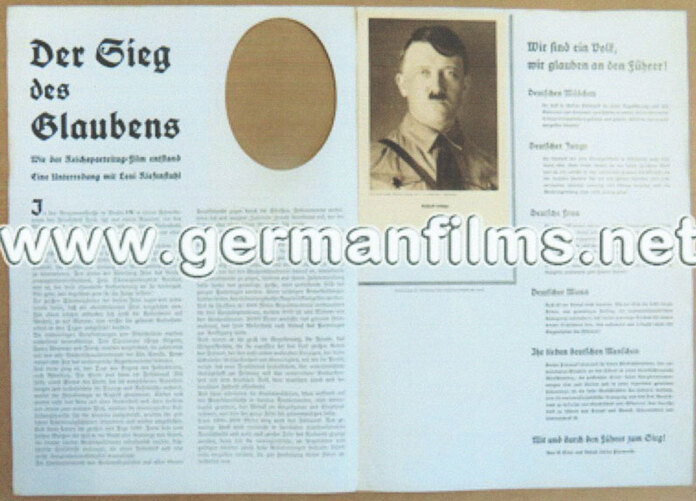
Back cover text
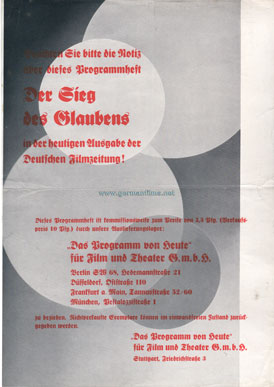
Please pay attention to this Notice
that this program issue
DER SIEG DES GLAUBENS
is in today’s issue of the
Deutsche Filmzeitung !
This program issue is on a commission basis available for a price of 5 1/2 Pfennig (Sales Price 10 Pfenning) acquired through our distribution warehouses:
“ Das Programm von Heute”
Für Film und Theater G.m.b.H.
Berlin SW 68, Hedemannstraße 21
Düsseldorf, Oststraße 110
Frankfurt a. Main, Taunusstraße 52/60
München, Pestalozzistraße 1
“ Das Programm von Heute”
Für Film und Theater G.m.b.H.
Stuttgart Friedrichstraße 3.
----------
BELOW, a sample of that Deutsche Filmzeitung newspaper mentioned (not the issue in which this film program was bundled.)
––––––––––––––––––––––––––––
Below: The 'illustrierter Film-Kurier' rotogravure film program from the competing Franke publishing house. Issues of this program were included in daily issues of the Film-Kurier Tageszeitung for new releases in cinemas. Copies of this Der Sieg des Glaubens program are relatively hard-to-find, and usually sell for €40–€50 each if in good condition:
